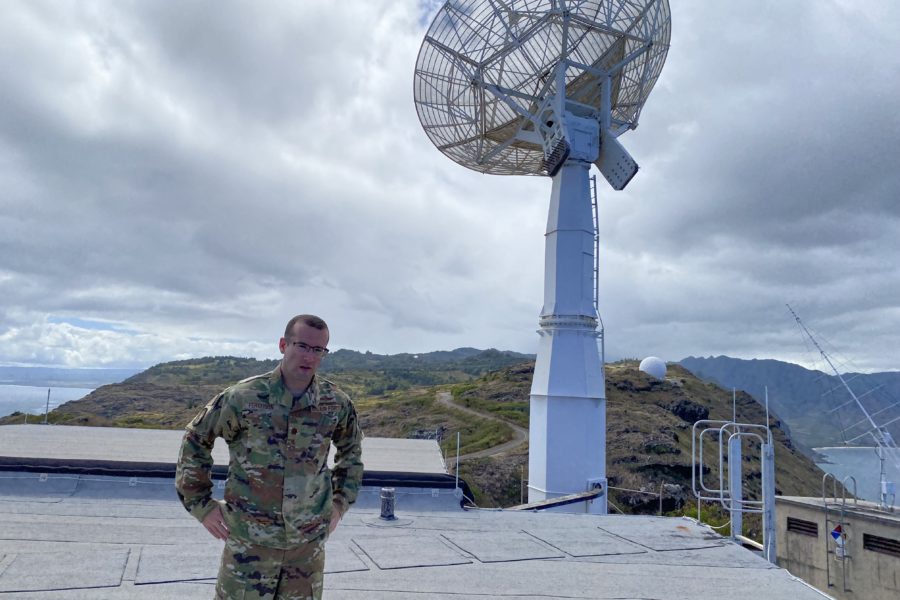KAENA POINT SPACE FORCE STATION, Oahu, Hawaii—At the rocky edge of a cliff on Hawaii’s Oahu island are poised three antenna dishes that rotate with the sun. Together, they form part of a global network to warn warfighters of solar activity that can disrupt radio signals and potentially send false data to the battlefield, a rising concern as the sun enters a cycle of increased activity.
“We listen to the sun—we don’t look at the sun,” Maj. Matthew Ferguson, commander of Detachment 5, 2nd Weather Squadron, at Kaena Point Space Force Station, Hawaii, told Air Force Magazine during a visit.
The Air Force’s 2nd Weather Squadron, headquartered at Offutt Air Force Base, Neb., provides solar electro-optical network operations through the Radio Solar Telescope Network (RSTN), situated at four global sites. Detachment 5 operates one of the RSTN sites, which has three Space Force-owned antenna dishes that listen to eight potentially dangerous frequencies.
In order to have ears on the sun at all times, the Air Force has three other detachments, in Learmonth, Australia; Sagamore Hill, Mass.; and San Vito, Italy.
“We listen to the sun, and we can pick up whenever the sun is causing radio interference through things like solar flares,” Ferguson said.
As the sun enters the solar maximum, an 11-year cycle of increased solar activity, larger numbers of sunspots are expected to occur and affect radio communications.
“We will see more sunspots and solar activity that will cause additional radio interference,” said Ferguson. Ferguson said the more sunspot areas that are detected, the greater the likelihood of solar flares and more radio frequency interference.
On the battlefield, that means radio communications errors, bad GPS data, and failed communication to and from satellites. Just one way space weather can affect GPS accuracy is when the ionosphere becomes “highly disturbed” and the GPS receiver can’t lock onto the signal, according to the National Oceanic and Atmospheric Administration.
“If you’re out doing a patrol and your GPS is off, then you could be in the wrong place. Or if their SATCOM is disrupted, they can’t talk back to base,” explained Space Force Maj. Brandon Hammond, commander of the 21st Space Operations Squadron, Detachment 3, at Kaena Point.
To prevent disruptions to missions, Ferguson and the other 2nd Weather Squadron commanders send reports to the Space Weather Operations Center, or Space WOC, at Offutt. There, operators prepare warnings and send them out to the entities with assets that may be affected.
“You can’t fix it—the sun is the sun,” added Hammond. “But that enables our forces to plan around that.”
But Ferguson admits that predicting space weather, specifically solar activity, is even harder than estimating weather patterns on Earth.
“It’s not like the regular weather, but maybe [there’s] a little bit of advance notice,” he said, noting that the solar maximum activity is expected to last for the next two to three years.
With the data the 2nd Weather Squadron collects, units across the joint force could receive as much as 12 to 24 hours of advance notice of a solar event that could impact their assets.
“Or as little as no time at all,” said Ferguson.
The trouble is, with salty conditions in the Pacific Ocean and myriad other threats, the solar monitoring equipment at Kaena Point is old and requires constant maintenance to stay operational.
The downtime of the current systems means sometimes only one antenna monitors the sun at a time or there is potentially a gap in monitoring if multiple systems are down at the same time.
To discuss recent repairs, Ferguson grabbed onto a rusty metal ladder fastened to the side of his detachment headquarters and started climbing to the rooftop. There, with the north and east shores of Oahu behind him, he looked up at the largest antenna he is responsible for at 28 feet.
“A lot of it is obsolete, and it’s overdue for replacements,” he said. He then described mechanical repairs that took the antenna out of operation for two weeks in January.
“That one was ‘Big Bertha.’ She was having some problems last year,” he said with a laugh. “We treat her nice now. She’s been working pretty well for us since the major overhaul.”
